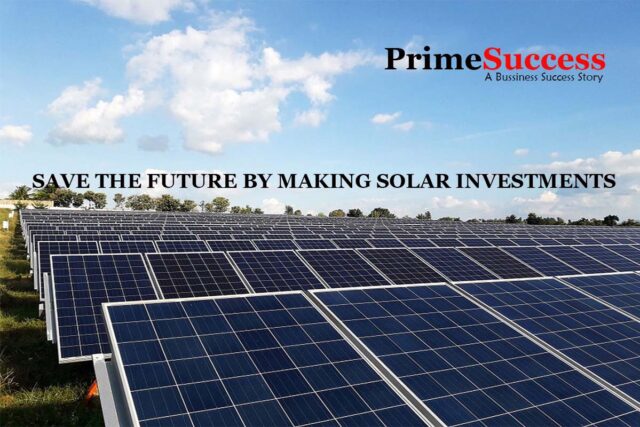SAVE THE FUTURE BY MAKING SOLAR INVESTMENTS
What if we could discover a fresh source of energy that would not pollute the environment and be friendly to the Earth’s ecosystem, allowing our planet and its atmosphere to heal. Is there a power source that can be used indefinitely, emits no carbon emissions, and is less expensive and more environmentally friendly than alternatives like coal, natural gas, and nuclear power? one that coexists peacefully with renewable energy sources like wind and solar power? And lastly, a power source that will beam electricity straight to the world’s most remote and underdeveloped nations, improving everyone’s level of living?
The solution is space solar power (SSP). There are no technological impediments to the use of solar electricity in space, all that is required is the will to do so. Space solar power won’t be impacted by weather, unlike solar panels on the earth. There are no hazardous by-products, in contrast to nuclear power. Space solar power is also better for the environment than burning fossil fuels. Let’s start the process of getting Earth back to being pure, natural, and unpolluted. The future is clearly in solar energy from space.
What is Solar Energy?
The heat and light from the Sun are captured to produce solar energy. Solar energy is the name for Sun-derived energy. Numerous ways to make use of this plentiful resource have been made possible by technology. As a result of its lack of greenhouse gas emissions, it is regarded as a green technology. Solar technologies are capable of providing heat, cooling, natural lighting, power, and fuels for a variety of uses. Through photovoltaic panels or mirrors that concentrate solar radiation, solar technologies transform sunlight into electrical energy. In the past 10 years, the cost of producing solar panels has fallen precipitously, making them not only accessible but frequently the cheapest source of power.
Depending on the type of material used in production, solar panels have a lifespan of around 30 years and come in a range of colors.
How Does Solar Energy Work?
The intensity of the energy that reaches the Earth’s surface is only moderately high due to solar radiation’s radial dispersion as it travels from the far-off Sun, despite being the greatest energy source to reach the planet. More of this sunlight is lost in the atmosphere of the Earth as a result of clouds, which together disperse up to 54% of the incoming light.
As a result, the quantity of visible light and infrared radiation in sunlight that reaches the ground is almost equal to that of visible light, with the remainder consisting of minute amounts of ultraviolet and other forms of electromagnetic radiation.
Despite the fact that much of the solar energy is lost on the way to the Earth’s surface, it still has a daily equivalent energy of around 200,000 times the world’s whole power generation capacity. However, because collection, conversion, and storage are still rather expensive, it might be challenging to fully use this renewable resource. Solar radiation can be used to generate thermal (heat) energy, which is more easily accomplished, or electrical energy, for example, using solar panels.
Advantages of Solar Energy
1. After installation, solar electricity produces no greenhouse emissions and is clean.
2. Year-round access to clean renewable energy, even on overcast days may generate some electricity.
3. Return on investment, as opposed to paying energy bills.
4. Solar panels require almost no maintenance because they endure for over 30 years.
5. Helps the economy by generating jobs by hiring solar panel makers, solar installers, etc.
6. If the grid is inner-tied, surplus energy can be sold back to the utility.
7. Can be placed in almost any place, from a field to a structure.
8. Store more energy using batteries to use at night.
9. You may utilize solar energy to power buildings, residences, and even automobiles to heat water.
10. Less risky than conventional electric current.
11. Since the solar can be near or at the site of installation, there is no requirement for trenching.
Disadvantages of Solar Energy.
1. Expensive initial material and installation expenses with slow ROI (however, with the reduction in the cost of solar over the last 10 years, solar is becoming more cost feasible every day).
2. Requires a substantial amount of space because efficiency is not yet 100%
3. There is no solar power available at night, thus a sizable battery bank is required.
4. For the same amount of electricity output, solar panel sizes vary depending on location.
5. Energy production decreases on cloudy days.
6. The inability of materials and technology to bring down the price of solar panels sufficiently to make them more accessible prevents their mass production (this is starting to change)
7. Solar-powered vehicles lack the same acceleration and power as standard gas-powered vehicles (this too is starting to change)
8. Winter months have lower sun production.
FREQUENTLY ASKED QUESTIONS ABOUT SOLAR ENERGY
1. What is the purpose of solar energy?
Solar energy may be used for a variety of things, including cooking, cleaning water, producing hydrogen, transporting, and more. It can also be used for heating, ventilation, and cooling.
2. Are solar energy sources renewable?
The Earth may be powered entirely by solar energy, which is green and renewable. No pollutants or dangerous by-products are produced when energy is produced by solar panels.
3. Are solar energies effective?
Depending on location, direction, and weather conditions, most current solar panels convert 15–22% of solar radiation into usable power. Performance is the ability of a solar panel to transform sunlight into electricity.
CONCLUSION
Since ancient times, people have used the inherent force of the sun to purify water, increase agricultural yields, and offer light and warmth. Around 200,000 times more energy than the entire globe can generate in a single day of electricity hits the Earth’s surface every day. A renewable and clean energy source that might supply enough energy for the entire planet is solar energy, which can be used to produce electricity and solar thermal energy for a variety of diverse purposes. Solar will play a bigger role in the global clean energy mix going forward to help us reach the Net Zero targets as solar technology and efficiency advancement and costs fall. Solar energy is a natural resource that is free to use and is expanding in a variety of uses. It may be utilized actively, passively, or as a source to create other fuels like hydrogen.










